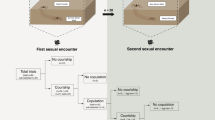Summary
Sexual competition is shown to occur in the social spiderStegodyphus dumicola (Eresidae). While the secondary sex ratio inS. dumicola was female-biased, the overall operational sex ratio (numbers of breeding males to breeding females over the season) showed no strong female bias. Males matured before females and had a shorter lifespan than the females. Mating took place in the natal colony. Males fought over access to the few mature females available early in the reproductive season, but females appeared to control the duration of mating. Later in the season, some adults of both sexes dispersed alone to breed elsewhere. We conclude that different rates of maturation between the sexes within a colony provide the opportunity for females that mature early in the season to be choosy in selecting a mate and this forces males to compete. Early reproduction may be beneficial for both females and males, because the offspring of females that reproduce early may have a competitive advantage over later (and smaller) offspring in the colony.
Similar content being viewed by others
References
Austad, S. N., 1984. Evolution of sperm priority patterns in spiders. In:Sperm competition and the evolution of animal mating systems (R. L. Smith, Ed.), Academic Press, NY, pp. 223–249.
Avilés, L., 1993a. Interdemic selection and the sex ratio: a social spider perspective.Am. Nat. 142:320–345.
Avilés, L., 1993b. Newly-discovered sociality in the neotropical spiderAebutina binotata Simon (Dictynidae?).J. Arachnol. 21:184–193.
Avilés, L., 1995. Causes and consequences of cooperation and permament-sociality in spiders: a review of non-territorial permanent-social spiders. In:Social competition and cooperation in insects and arachnids, Vol. 2, evolution of sociality (B. Crespi and J. Choe, Eds.), Princeton Univercity Press, Princeton (in press).
Bradoo, B. L., 1975. The sexual biology and morphology of the reproductive organs ofStegodyphus sarasinorum Karsch (Araneae: Eresidae).Entomol. Monthly Mag. 111:239–247.
Heller, K.-G. and D. von Heiversen, 1991. Operational sex ratio and individual mating frequencies in two bushcricket species (Orthoptera, Tettigonioidea, Poecilimon).Ethology 89:211–228.
Henschel, J., J. Schneider and Y. Lubin, 1995. Dispersal mechanisms by the spidersStegodyphus: Do they balloon?J. Arachnol. in press.
Henschel, J. R., D. Ward and Y. Lubin, 1992. The importance of thermal factors for nest-site selection, web construction and behaviour ofStegodyphus lineatus (Araneae: Eresidae) in the Negev Desert.J. therm. Biol. 17:97–106.
Jackson, R. R., 1978. Male mating strategies of dictynid spiders with differing types of social organization.Symp. Zool. Soc., London 42:79–88.
Jacson, C. C. and K. J. Joseph, 1973. Life-history, bionomics and behaviour of the social spiderStegodyphus sarasinorum Karsch.Ins. Soc. 20:189–204.
Krafft, B., 1969. Various aspects of the biology ofAgelena consociata Denis when bred in the laboratory.Am. Zoologist 9:201–210.
Kraus, O. and M. Kraus, 1988. The genusStegodyphus (Arachnida, Araneae). Sibling species, species groups, and parallel origin of social living.Ver. naturwiss. Ver. Hamburg 30:151–254.
Lubin, Y. D., 1986. Courtship and alternative mating tactics in a social spider.J. Arachnol. 14:239–257.
Lublin, Y. D. and R. H. Crozier, 1985. Electrophoretic evidence for population differentiation in a social spiderAchaeranea wau (Theridiidae).Ins. Soc. 32:297–304.
Riechert, S. E. and R. M. Roeloffs, 1993. Evidence for and consequences of inbreeding in the co-operative spiders. In:Natural history of inbreeding and outbreeding (N. Thornhill, Ed.), University of Chicago Press, Chicago, pp. 283–303.
Roeloffs, R. M. and S. E. Riechert, 1988. Dispersal and population-genetic structure of the co-operative spider,Agelena consociata, in West African rainforest.Evolution 42:173–183.
Rypstra, A. L., 1993. Prey size, social competition, and the development of reproductive division of labor in social spider groups.Am. Nat. 142:868–880.
Schneider, J., 1992. Die Wurzeln des Soziallebens bei der subsozialen SpinneStegodyphus lineatus (Eresidae). PhD dissertation, Ludwig-Maximilian-Universität, München, Germany, 135 pp.
Seibt, U. and W. Wickler, 1987. Gerontophagy versus cannibalism in the social spidersStegodyphus mimosarum Pavesi andStegodyphus dumicola Pocock.Anim. Behav. 35:1903–1904.
Seibt, U. and W. Wickler, 1988. Bionomics and social structure of “Family Spiders” of the genusStegodyphus, with special reference to the African speciesS. dumicola andS. mimosarum (Araneida, Eresidae).Verh. naturwiss. Ver. Hamburg 30:255–303.
Smith, D. R., 1986. Population genetics ofAnelosimus eximius (Araneae, Theridiidae).J. Arachnol. 14:201–217.
Smith, D. R. and M. S. Engel, 1994. Population structure in an Indian cooperative spider,Stegodyphus sarasinorum Karsch (Eresidae).J. Arachnol. 22:108–113.
Southwood, T. R. E., 1978. Ecological methods-with special reference to the study of insect populations. 2nd edition, Chapman & Hall, London.
Thornhill, R. and J. Alcock, 1983. The Evolution of Insect Mating Systems. Harvard University Press, Cambridge, MA.
Vollrath, F., 1986. Eusociality and extraordinary sex ratios in the spiderAnelosimus eximius (Araneae: Theridiidae).Behav. Ecol. Sociobiol. 18:283–287.
Ward, D. and Y. Lubin, 1993. Habitat selection and the life history of a desert spider,Stegodyphus lineatus (Eresidae).J. Anim. Ecol. 62:353–363.
Ward, P. I. and M. Enders, 1985. Conflict and cooperation in the group feeding of the social spiderStegodyphus mimosarum.Behaviour 94:167–182.
Wickler, W. and U. Seibt, 1986. Aerial dispersal by ballooning in adultStegodyphus mimosarum.Naturwiss. 75:628–629.
Wickler, W. and U. Seibt, 1993. Pedogenetic sociogenesis via the “Sibling-route” and some consequences forStegodyphus spiders.Ethology 95:1–18.
Willey, M. B. and R. R. Jackson, 1993. Predatory behavior of a social spider,Stegodyphus sarasinorum (Araneae: Eresidae): why attack first?Can. J. Zool. 71:2220–2223.
Author information
Authors and Affiliations
Rights and permissions
About this article
Cite this article
Henschel, J.R., Lubin, Y.D. & Schneider, J. Sexual competition in an inbreeding social spider,Stegodyphus dumicola (Araneae: Eresidae). Ins. Soc 42, 419–426 (1995). https://doi.org/10.1007/BF01242170
Received:
Revised:
Accepted:
Issue Date:
DOI: https://doi.org/10.1007/BF01242170




